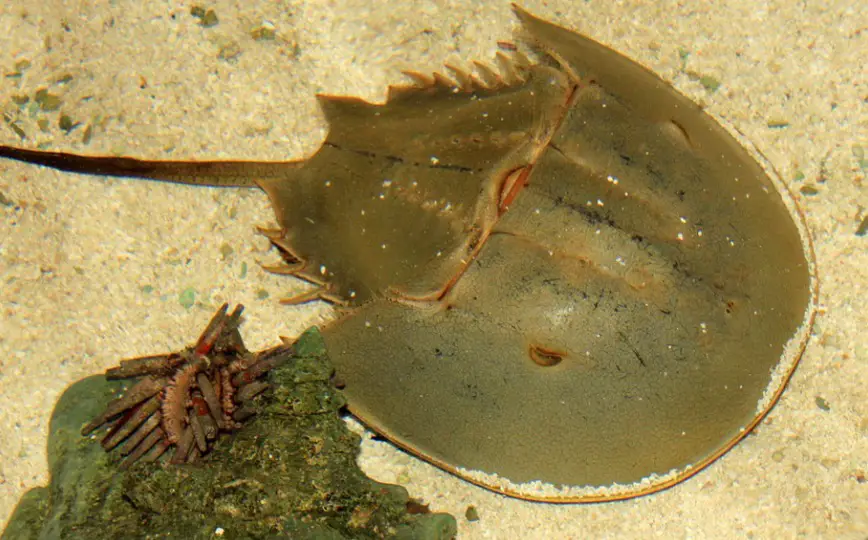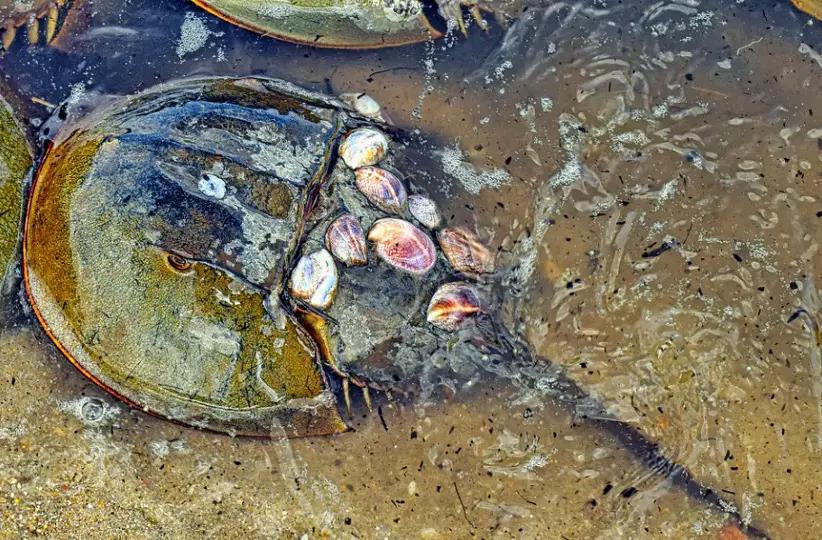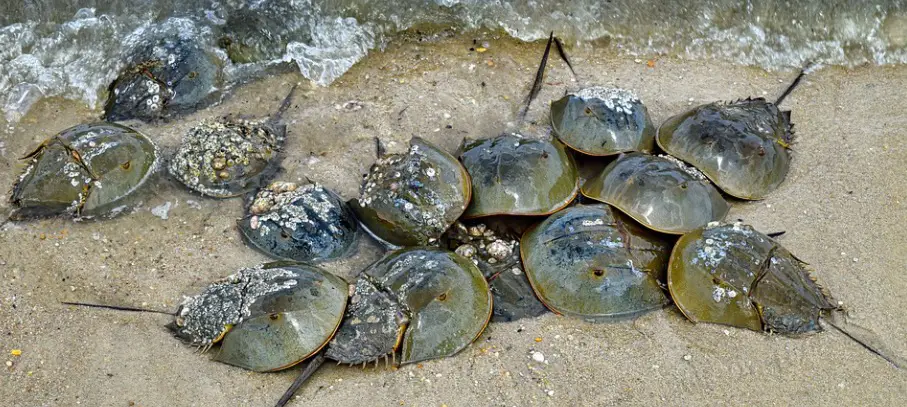Table of Contents
Horseshoe Crab: All You Need To Know
A Horseshoe crab is a prehistoric carnivorous animal that belongs to the kingdom of Animalia, phylum Arthropoda, and class Merostomata. It has 3 genera, and 4 species. Its length is up to 46 to 48 cm for females and 36 to 38 cm for males, and it weighs about 1 to 4.5 kg. It lives on the ocean floor, with a lifespan up to 20+ years.

What is Horseshoe Crab?
The Horseshoe Crab is an ancient animal that belongs to the Arthropoda family, which has been around for about 400 million years. This puts them ahead of the dinosaurs in age! Horseshoe crabs are neither real crabs nor crustaceans, despite their common name.
Horseshoe crabs belong to the Xiphosura order and are more closely connected to scorpions and spiders than they are to ancient crabs. They may be found in both marine and brackish waters. Crustaceans, mollusks, and marine worms are all eaten by horseshoe crabs, which are carnivores.

Western horseshoe crabs, American horseshoe crabs (Limulus polyphemus), and Eastern horseshoe crabs, tri-spine horseshoe crabs (Tachypleus tridentatus), coastal horseshoe crabs (Tachypleus gigas), and mangrove horseshoe crabs are the four species of horseshoe crabs (Carcinoscorpius rotundicauda). Only North America, Central America, and Southeast Asia are home to horseshoe crabs.
Limulus polyphemus is a species of limulus that may be found in the Gulf of Mexico and the Atlantic Ocean. The three Eastern horseshoe crab species have a large range that includes Japan, China, Java, Sumatra, the Philippines, and India’s coasts. The tri-spine horseshoe crab is categorised as endangered, whereas the American horseshoe crab is classed as vulnerable. The IUCN’s red list will shortly include the other two species.
Horseshoe Crab Anatomy
The horseshoe crab derives its name from the rounded form of its head, which resembles that of a horseshoe. The brain, heart, neurological system, mouth, and numerous glands are all found in the prosoma, which is the biggest portion of its body and includes most of the neural systems and essential biological organs. The exoskeleton’s hard plate serves as a protective covering for the organs.

The next section of its anatomy is the abdomen, also known as the opisthosoma. It has spines on the sides and a ridge in the middle and is triangular in form. The horseshoe crab’s spines may move and help defend it. The gills, which are utilised for breathing, are located on the underside of the belly. The telson, or tail, is the last part of a horseshoe crab’s body.
The telson is long and pointed, and while it appears to be deadly, it is not. Horseshoe crabs mostly use their tails to help them correct themselves if they fall down. The 10 legs of the horseshoe crab allow it to travel over the ocean floor. Females are about a third bigger than males from head to tail.
Horseshoe Crab Life History
Horseshoe crabs spawn in the late spring and early summer, when the adults migrate from deep ocean water to the beach. Males arrive first and wait for females to arrive, who emit pheromones (natural chemicals) when they arrive on the beach.
These pheromones alert males that they have arrived and that it is time to mate. Before the males fertilise the eggs, the ladies dig tiny nests and lay their eggs. During high tides, this is generally done at night. The breeding couple may repeat the procedure several times, laying tens of thousands of eggs each time.

The eggs are a food source for a variety of birds, fish, and reptiles, so most horseshoe crabs will not make it to the larval stage. If a horseshoe crab egg is fortunate enough to avoid being eaten, it will hatch in about two weeks.
With the exception of the lack of a tail, the larva resembles the adult horseshoe crab. The larva travels into the ocean after hatching and spends about a year on the sandy floor of a tidal flat. They progress to deeper water as they mature, where they consume the same diet as adult crabs.
It takes a juvenile horseshoe crab around 10 years to mature into an adult. The horseshoe crab will moult 16 or 17 times throughout this time. They lose their tiny exoskeletons and build bigger shells as part of this process. In the spring, when they reach adulthood, they return to the beaches to reproduce. Horseshoe crabs have a lifespan of almost 20 years.
Fun Facts About Horseshoe Crab!
Horseshoe crabs are ancient creatures that have lived on the planet for millions of years. These creatures have been extensively studied and have a number of biological adaptations that have enabled them to live on the planet for such a long time. Let’s have a look at it more closely!
Horseshoe Crab in Biomedical Bleeding
Horseshoe crabs are essential to the biomedical sector because their blue blood includes a substance called Limulus amebocyte lysate (LAL), which is used to prevent germs from contaminating biomedical equipment and vaccinations. This is so essential to the business that the biomedical sector in the United States takes blood from around half a million horseshoe crabs each year for use in medicines.
After the crabs have been caught, up to 30% of their blood is extracted before they are released to the ocean floor. While the horseshoe crabs are returned to the water alive and healthy, studies have indicated that blood collection has a short-term effect on their behaviour. The scientists show that the crabs become disoriented throughout the harvesting procedure, which may have a detrimental influence on their reproduction!
Horseshoe Crabs Have Nine Eyes
Horseshoe crabs have nine eyes, and their eyesight has been the subject of a lot of scientific study. On the prosoma, there are two enormous compound eyes, one on each side. These eyes have monochromatic vision and are utilised mostly for mating.
On the carapace, they have five basic eyes: two median eyes, one endoparietal eye, and two rudimentary lateral eyes. Even unhatched embryos appear to be able to perceive light levels from within their eggs, indicating that these eyes are likely crucial during embryonic and larval development. Visible and UV light irritate the median eyes.
The photoreceptors in the primitive lateral eyes become functioning soon before the egg hatches. The crab’s remaining two eyes may be seen on the underside. These two ventral eyes, which are located near the animal’s mouth, are considered to aid in orienting the animal when swimming.
The horseshoe crab possesses a multitude of light-sensing organs down the length of its tail in addition to its nine eyes. The eyes of horseshoe crabs have been researched so thoroughly that one researcher, Dr. Hartline, was awarded the Nobel Prize in Physiology or Medicine in 1967 for his discovery of the optical nerve network using horseshoe crabs as a model.
Horseshoe Crab: A Living Fossils
Horseshoe crabs are referred to as “living fossils.” They’ve been around since before the dinosaurs existed! Horseshoe crabs have survived major extinctions and stayed essentially unaltered for over 400 million years.
Scientists use the phrase “living fossil” to describe creatures that have been extinct for millions of years and have few or no surviving descendants. Most of them have unique characteristics that make them appear to be from another world, and they provide a rare look into how life on Earth used to be. The komodo dragon, hagfish, koala, and pig-nosed turtle are some of the other species that are considered living fossils.
Horseshoe Crab Citations
- Simple Eyes, Extraocular Photoreceptors and Opsins in the American Horseshoe Crab. Integr Comp Biol . 2016 Nov;56(5):809-819.
- Horseshoe crab hemocyte-derived lectin recognizing specific O-antigens of lipopolysaccharides. Adv Exp Med Biol . 2001;484:185-90.
- Currently Available Recombinant Alternatives to Horseshoe Crab Blood Lysates: Are They Comparable for the Detection of Environmental Bacterial Endotoxins? A Review. PDA J Pharm Sci Technol . Sep-Oct 2020;74(5):602-611.
- Saving the horseshoe crab: A synthetic alternative to horseshoe crab blood for endotoxin detection. PLoS Biol . 2018 Oct 12;16(10):e2006607.







